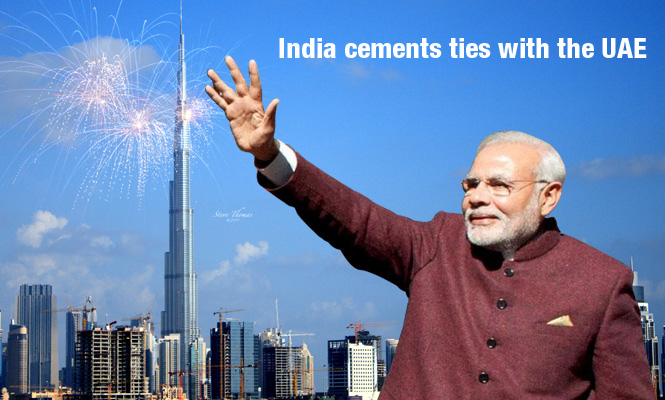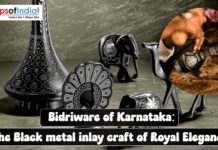It took 34 years for an Indian Prime Minister to reach out to India’s third largest trading partner, UAE and just two days to bridge the gulf and how! Prime Minister Narendra Modi has just concluded a highly successful visit to the UAE in a tour that will be remembered by both countries as path breaking and mutually beneficial.
The significance of his visit from UAE’s perspective can be gauged by the fact that His Highness Crown Prince Mohamed Bin Zayed Al Nahyan personally received PM Modi at the airport, along with his five brothers, thereby recognising India’s growing stature and influence as an emerging power.
The tour resulted in a commitment by UAE to invest a massive $75 billion in developing India’s infrastructure, and marks a new beginning in establishing a comprehensive strategic partnership between UAE and India that covers security cooperation, defence manufacturing, trade & investment, cultural exchange, education, research & development, medical services and sports.
UAE has been evolving as a multicultural cauldron that is increasingly welcoming people from diverse cultures to live and work there, contribute to UAE’s growth. In a remarkable indication of its openness and accommodating stance, the Crown Prince has decided to allocate land to build a temple in UAE, a first and very welcome move, for the Indian diaspora living there. This is yet another validation of UAE’s intent in strengthening its ties with India.
Understanding the importance of UAE in the Indian context
India happens to be UAE’s second largest trading partner, while UAE is India’s third largest trading partner. This reflects not only the extent of business ties between both countries but also the potential for further expansion.
There are over 7 million Indian citizens living and working in the Gulf region, of which UAE alone accounts for 2.5 million. That’s a sizeable number, for it is this section that has had a huge role to play in the economic development of UAE, at all levels, and is also a significant contributor of foreign remittances to India.
PM Modi had the foresight to recognise the importance of UAE not only as a source of investment but an important gateway to the Middle East. Therefore, let’s analyse the gains for India from this tour and also its potential impact on both countries.
Trade
It is indeed surprising to note that for 34 years no Indian Prime Minister had taken the initiative to visit the UAE as it did not rank high on the diplomatic order. Today, the Abu Dhabi Investment Authority (ADIA) holds over $800 billion in sovereign fund and this needs to be invested.
India is a favoured investment destination amongst all emerging markets and is well placed to absorb a sizeable share of this fund. Therefore, UAE’s commitment to invest $75 billion in the India growth story comes as a very welcome move for both countries. Over time and growing relations, the amount of investment could well increase.
India and the UAE share trading ties that go back centuries and along with trade came culture and knowledge exchange. In fact, Indians were amongst the first to reach the Gulf States once the region opened up to investment in the late sixties and early seventies. The rest is history. Indians today are involved in white and blue collar jobs in almost all sectors, while the trading community has Indians holding a major presence.
Much like India, UAE has been actively pursuing infrastructure development along with developing its social services and today, the UAE has emerged as a cosmopolitan mix of various cultures that seamlessly blends the traditional with the modern. India too is in transition and now UAE is going to play a major part in it through investment and exchange of knowledge and information. India is looking to absorb over a $ 1 trillion in infrastructure investment alone and this trip has paved the way for UAE’s contribution to grow in coming time.
Energy security
UAE has realised the importance of investing in alternate and green energy to meet its future requirements and India is in a position to share its experience and manufacturing base to cater to UAE’s needs. On the other hand, UAE is looking to invest in India’s energy sector and is in a position to offer investment and technology in oil & gas exploration, petrochemical refining and processing, and developing upstream & downstream projects.
For India, UAE is also an important gateway to the Middle East, both geographically and politically. UAE has an important say in the Organization of Islamic States (OIC), and therefore a friendly UAE can be an asset to securing India’s energy requirements from the region. This tour has succeeded in cementing this relationship.
Cooperation in defence and security
Terror and security has been a growing concern among the GCC states. With many countries in the Middle East and West Asia embroiled in civil strife and sectarian violence, ISIS has entered an already volatile space and is threatening to destabilise all countries in the region.
Over the years, within certain pockets of UAE, criminal elements having connections with terror outfits found a safe haven. One of the highlights of PM Modi’s tour has been to garner complete support from the UAE resulting in the strong ‘joint statement’ being released by both countries wherein, UAE has clearly defined terror and has accepted India’s draft proposal on Comprehensive Convention on International Terrorism (CCIT) pending at the United Nations.
This is seen as an important first step for the rest of OIC member states in accepting the same. In a clearly worded statement, both countries have condemned the use of religion as an excuse for terror and have also condemned countries supporting terror, directly or indirectly, in any form. Pakistan, which has had a lot of soft support from various sections in the GCC states, especially the UAE, thus far, will now face the heat with UAE’s unambiguous position, which is also seen as a clear vindication of India’s stand.
As a mark of further deepening ties, both countries announced closer cooperation on intelligence sharing on terrorism and counter terrorism, cybersecurity, training of defence personnel, cooperation in joint manufacturing and supply of military equipment. India plays an important role in securing the Indian Ocean Region and this trip by the Prime Minister has opened up UAE’s participation in the forthcoming International Fleet Review, the naval exercise being organised by India in February 2016.
Education
UAE is investing a lot on education and sees India as an important partner for providing a variety of high quality academic inputs in the form of teachers, training material and technology. As India itself continues on the path of improving its educational ecosystem, UAE could well prove a supporting partner in the Indian initiative.
Medical services
India is already providing a large pool of doctors, nurses and technicians to the health sector in the UAE and this visit is going to further strengthen that initiative. The Indian health sector requires a lot of investment and UAE could step in with much needed investment support. India has a lot to offer the UAE in terms of research and development in the health space and in coming times, this cooperation can only increase.
Technology
UAE is pursuing green and sustainable technology as part of its future urban development and is open to investing in high technology areas like medicine, electronics and space. To showcase its ambitious zero carbon city, MASDAR, His Highness the Crown Prince himself escorted PM Modi in a state-of-the-art self-driven vehicle.
UAE is investing heavily in developing its space technology and is planning a Mars mission by 2022. It seeks India’s support for extending knowledge sharing and cooperation in space technology and research.
And finally, PM Modi’s ‘Madison Garden’ moment in a packed Dubai Stadium!
Culminating his hectic but very fruitful 2-day tour, PM Modi addressed a 50,000 plus, highly charged, excited and vociferous Indian diaspora. In a repeat of his Madison Garden experience, the Prime Minister was at his oratorical best, fully playing to the gallery, invoking patriotism while recognising the hard work, diligence and entrepreneurship of the Indian diaspora in building a modern UAE.
Taking full advantage of the moment, he also used the opportunity to send out a strong message to Pakistan that it had to decide whether it was in favour or against terror. He didn’t spare the opposition at home either, when he rubbed the fact that it took 34 years for a PM to visit UAE despite over 700 flights operating to and from the area.
Without doubt, this trip will be seen as one of his most successful visits overseas, and the country hopes that the follow-up on this by both countries is equally strong and effective. It may have taken 34 years but what has now started is going to go a long way in cementing ties between two ancient cultures.
Read Also:
India’s foreign trade – Rising beyond mere relations
Poverty and its causes in India
India’s Foreign Policy
A long way to go for India
Modi Foreign Visits Map
Expectations from Modi’s impending visit to Japan
Modi’s US visit
PM Modi’s Tour of Russia and Central Asia
Modi’s Three-nation Visit: China, Soth Korea & Mongolia
Indian Ocean Yatra
Modi Visit Boosts Indo-Nepal Relations
India Needs To Revive International Relations





